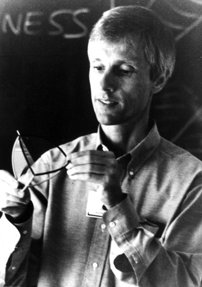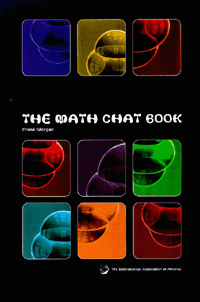- About MAA
- Membership
- MAA Publications
- Periodicals
- Blogs
- MAA Book Series
- MAA Press (an imprint of the AMS)
- MAA Notes
- MAA Reviews
- Mathematical Communication
- Information for Libraries
- Author Resources
- Advertise with MAA
- Meetings
- Competitions
- Programs
- Communities
- MAA Sections
- SIGMAA
- MAA Connect
- Students
- MAA Awards
- Awards Booklets
- Writing Awards
- Teaching Awards
- Service Awards
- Research Awards
- Lecture Awards
- Putnam Competition Individual and Team Winners
- D. E. Shaw Group AMC 8 Awards & Certificates
- Maryam Mirzakhani AMC 10 A Awards & Certificates
- Two Sigma AMC 10 B Awards & Certificates
- Jane Street AMC 12 A Awards & Certificates
- Akamai AMC 12 B Awards & Certificates
- High School Teachers
- News
You are here
Frank Morgan's Math Chat - Which One Is Older?
 |
 |
July 20, 2000
Videos. What I consider the best two math videos of all time are now available from the Mathematical Sciences Research Institute via the MAA. "Mathematics in Arcadia" contains short excerpts from Tom Stoppard's hit Arcadia, loaded with mathematics, interspersed with conversations between the playwright and mathematician Robert Osserman:
Stoppard: Could you explain entropy?
Osserman: No [laughter].
Stoppard: I'll do it. Entropy is something every mother with a teenage daughter understands, which is that if you just move the stuff around in your bedroom without any plan or thought, it gets untidier; it never gets tidier. [What a perfect explanation!]
The second video, "Fermat's Last Theorem," as seen on TV as "The Proof" on NOVA, captures Wiles's emotional experience in solving the 350-year-old problem:
Wiles: Suddenly, totally unexpectedly, I had this incredible revelation. The most important moment of my working life. Nothing I can do again will . . . [unable to finish].
Old Challenge (Matthias Weber). How can two people determine which is older without revealing their ages? No outside help is permitted. You may assume that their ages are different.
Answer. The best solution comes from Raymond Hettinger: "Have one of the two people put 100 consecutively numbered post-it notes on her desk with a check mark on the underside if the number is less than her age, and then leave the room. The other person enters, looks under the one note with his own age and learns from the check mark whether his age is higher or lower. After replacing the post-it, he shares the information with his friend but does not say which post-it he examined."
In another interesting solution, Reiner Schatzle, of ETH Zurich, suggests that they synchronize their watches, agree that each minute after noon represents a year after 1850, and wait separately in outer chambers until their years of birth, at which time they briefly revisit a central room. The first visitor writes "I am the older" on a tablet, and the second visitor writes underneath, "I am the younger."
Some other answers involved placing partially filled containers on a balance scale.
New Challenge (John Shonder). A small creature needs to find its way from a random point on an mile-wide strip of land to the sea on either side, by going distance r in a random direction and then (if it has not yet found the water), turning once t degrees to the right and continuing thereafter in a straight line. What choices of r and t minimize the expected journey length to the sea?
MATH CHAT is now available directly at MathChat.org.
Send answers, comments, and new questions by email to Frank.Morgan@williams.edu, to be eligible for Flatland and other book awards. Winning answers will appear in the next Math Chat. Math Chat appears on the first and third Thursdays of each month. Prof. Morgan's homepage is at www.williams.edu/Mathematics/fmorgan.
THE MATH CHAT BOOK, including a $1000 Math Chat Book QUEST, questions and answers, and a list of past challenge winners, is now available from the MAA (800-331-1622).
Copyright 2000, Frank Morgan.




